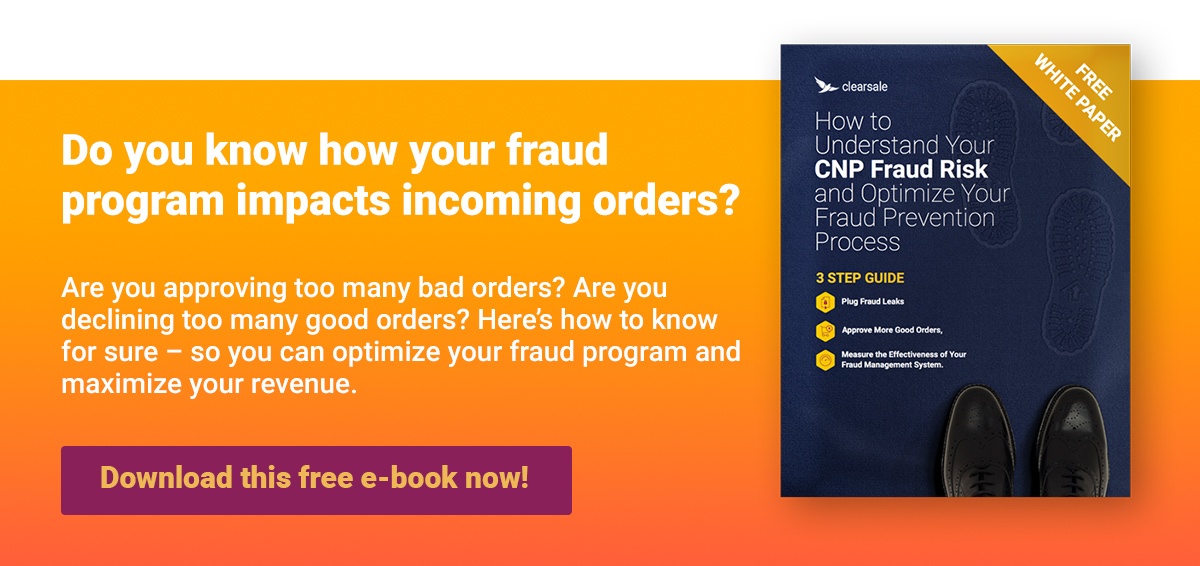E-Commerce Fraud Prevention: Best Practices for Using Fraud Scores
Merchants that sell online need to be sure every order is valid. One vital data point is a fraud score – a numeric score that reflects the risk level of an order, based on multiple transaction details.
It’s a number that can help you quickly gauge whether an order might be fraudulent or not. But do you know how to use fraud scores for your approve-decline decisions?
While fraud-scoring programs can help flag questionable transactions for further review, which can prevent false declines and reduce chargebacks, these programs may not help a merchant at all if they aren’t configured correctly.
Here are the top questions e-commerce merchants are asking about fraud scores, how to maximize their use, and the best practices for using them.
What Is a Fraud Score?
A fraud score uses predictive techniques to capture patterns of fraudulent activity, based on information about a transaction(like IP address, AVS result, shipment method, billing/shipping addresses, and type of email address), differentiate these patterns from legitimate purchasing activity, and turn it into a numeric value that indicates the probability that a transaction may be fraudulent.
When merchants send all the details of an order to the service, the service scans the data, looking for unusual or potentially fraudulent entries. Some services may also look at velocity issues, address and phone number verification, and other factors — even comparing all the data against previously evaluated orders.
At the end of the evaluation, the service returns a score, which e-commerce merchants can use to approve, reject or further review orders. The more accurate the fraud score is, the better a merchant will be at correctly approving or declining transactions.
How Important Is an Accurate Fraud Score?
If an e-commerce merchant’s fraud prevention program uses only automatic fraud detection tools or simple fraud filters, accurate fraud scores can help increase transaction approval levels, reduce chargeback rates, and lower false decline rates.
If a merchant manually reviews every order, fraud scores are essential for guiding their team throughout the review and decision process.
Fraud scores also make it easier to decide which transactions to manually review, especially during periods of high sales volume, compared to strict decision tree rules. In addition, the volume of transactions that can be sent for manual review is much bigger and more flexible with a fraud score, as this can be updated by simply changing the threshold value.
What Makes Fraud Scores Inaccurate?
When merchants have high false decline rates, fraud scores become less accurate. And as fraud scores decrease in accuracy, false decline rates tend to skyrocket. It’s a vicious cycle.
When merchants don’t know false declines are even happening — much less the reason for them — they don’t know to update their fraud scoring techniques. And that exacerbates the problem. Falsely declined orders don’t give any feedback to the fraud scoring model and can’t help the system become more adept at distinguishing between legitimate and fraudulent customer behavior.
As a result, a merchant’s “gray area” orders — those clusters of transactions that aren’t obviously legitimate or fraudulent — tend to increase.
And if merchants include too many items in their fraud score and manual review, the chances also increase that the customer will be declined.
Why Do Fraud Scores Vary?
For fraud scores to be effective, they need to be created based on the variables that are important to individual industries and businesses.
For example, e-commerce merchants selling physical products may consider shipping address information to be extremely important to their fraud score, because that’s how customers get the product. But for the travel industry, because customers receive airline tickets and other confirmations by email, shipping addresses may be less important.
Merchants Can Control How Their Score Is Calculated
Most e-commerce teams have minimal information about what specific data their e-commerce platform or payment service uses to calculate fraud scores. In fact, the only information teams may be able to get from their provider is the score number. This makes it even more important for merchants to work with a provider that’s willing to customize fraud scoring to individual business.
But before merchants select a customizable option, they need to ensure it’s the right solution for their business. That means ensuring the fraud score incorporates the parameters they need, like accuracy rate (the proportion of the total number of correct predictions) and ensuring the quality of the score by K-S measurement (the degree of separation between positive and negative fraud distributions).
Once merchants find the option that includes the right parameters, they can work with the provider to reweight the variables — or even create new ones — that make sense for their business.
Mitigate Risk with a Fraud Prevention Program
Picking the right fraud scoring service depends on the merchant’s industry, business, and the way they sell their products and services. And even then, fraud scores may not truly capture a transaction’s full risk potential.
So if fraud scores alone can’t offer comprehensive protection, what can merchants do to reduce their risk exposure?
ClearSale’s comprehensive e-commerce fraud prevention program might be the answer. Using a unique combination of highly trained staff and advanced artificial intelligence, ClearSale has been helping companies in all industries reduce fraud risk. Contact us to see if our managed services solution is right for you, too.
 Sarah Elizabeth
Sarah Elizabeth
